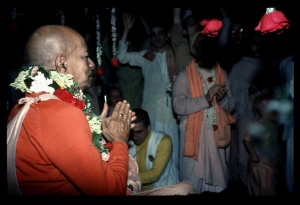CC Antya 2.31: Difference between revisions
m (1 revision(s)) |
(Vanibot #0054 edit - transform synonyms into clickable links, which search similar occurrences) |
||
| (One intermediate revision by one other user not shown) | |||
| Line 1: | Line 1: | ||
{{ | [[Category:Sri Caitanya-caritamrta - Antya-lila Chapter 02|C031]] | ||
<div style="float:left">'''[[Sri Caitanya-caritamrta|Śrī Caitanya-caritāmṛta]] - [[CC Antya|Antya-līlā]] - [[CC Antya 2|Chapter 2: The Chastisement of Junior Haridāsa]]'''</div> | |||
<div style="float:right">[[File:Go-previous.png|link=CC Antya 2.30|Antya-līlā 2.30]] '''[[CC Antya 2.30|Antya-līlā 2.30]] - [[CC Antya 2.32|Antya-līlā 2.32]]''' [[File:Go-next.png|link=CC Antya 2.32|Antya-līlā 2.32]]</div> | |||
{{CompareVersions|CC|Antya 2.31|CC 1975|CC 1996}} | |||
{{RandomImage}} | |||
==== TEXT 31 ==== | ==== TEXT 31 ==== | ||
<div class="verse"> | |||
<div | :’gaura-gopāla mantra’ tomāra cāri akṣara | ||
’gaura-gopāla mantra’ tomāra cāri akṣara | :aviśvāsa chāḍa, yei kariyācha antara“ | ||
aviśvāsa chāḍa, yei kariyācha antara“ | |||
</div> | </div> | ||
| Line 13: | Line 16: | ||
==== SYNONYMS ==== | ==== SYNONYMS ==== | ||
<div class="synonyms"> | |||
<div | ''[//vanipedia.org/wiki/Special:VaniSearch?s=gaura&tab=syno_o&ds=1 gaura]-[//vanipedia.org/wiki/Special:VaniSearch?s=gopāla&tab=syno_o&ds=1 gopāla] [//vanipedia.org/wiki/Special:VaniSearch?s=mantra&tab=syno_o&ds=1 mantra]'' — the Gaura-gopāla ''mantra''; ''[//vanipedia.org/wiki/Special:VaniSearch?s=tomāra&tab=syno_o&ds=1 tomāra]'' — your; ''[//vanipedia.org/wiki/Special:VaniSearch?s=cāri&tab=syno_o&ds=1 cāri] [//vanipedia.org/wiki/Special:VaniSearch?s=akṣara&tab=syno_o&ds=1 akṣara]'' — composed of four syllables; ''[//vanipedia.org/wiki/Special:VaniSearch?s=aviśvāsa&tab=syno_o&ds=1 aviśvāsa] [//vanipedia.org/wiki/Special:VaniSearch?s=chāḍa&tab=syno_o&ds=1 chāḍa]'' — give up your doubts; ''[//vanipedia.org/wiki/Special:VaniSearch?s=yei&tab=syno_o&ds=1 yei]'' — which; ''[//vanipedia.org/wiki/Special:VaniSearch?s=kariyācha&tab=syno_o&ds=1 kariyācha] [//vanipedia.org/wiki/Special:VaniSearch?s=antara&tab=syno_o&ds=1 antara]'' — you have kept within your mind. | ||
gaura-gopāla | |||
</div> | </div> | ||
| Line 21: | Line 23: | ||
==== TRANSLATION ==== | ==== TRANSLATION ==== | ||
<div class="translation"> | |||
<div | "You are chanting the Gaura-gopāla mantra, composed of four syllables. Now please give up the doubts that have resided within you." | ||
</div> | </div> | ||
==== PURPORT ==== | ==== PURPORT ==== | ||
<div class="purport"> | |||
Śrīla Bhaktivinoda Ṭhākura explains the Gaura-gopāla ''mantra'' in his ''Amṛta-pravāha-bhāṣya''. Worshipers of Śrī Gaurasundara accept the four syllables ''gau-ra-aṅ-ga'' as the Gaura ''mantra'', but pure worshipers of Rādhā and Kṛṣṇa accept the four syllables ''rā-dhā'' ''kṛṣ-ṇa'' as the Gaura-gopāla ''mantra''. However, Vaiṣṇavas consider Śrī Caitanya Mahāprabhu nondifferent from Rādhā-Kṛṣṇa (''śrī-kṛṣṇa-caitanya rādhā-kṛṣṇa nahe anya''). Therefore one who chants the ''mantra'' ''"gaurāṅga"'' and one who chants the names of Rādhā and Kṛṣṇa are on the same level. | |||
</div> | |||
<div | <div style="float:right; clear:both;">[[File:Go-previous.png|link=CC Antya 2.30|Antya-līlā 2.30]] '''[[CC Antya 2.30|Antya-līlā 2.30]] - [[CC Antya 2.32|Antya-līlā 2.32]]''' [[File:Go-next.png|link=CC Antya 2.32|Antya-līlā 2.32]]</div> | ||
__NOTOC__ | |||
</div> | __NOEDITSECTION__ | ||
__NOTOC__ | |||
Latest revision as of 20:14, 19 February 2024

A.C. Bhaktivedanta Swami Prabhupada
TEXT 31
- ’gaura-gopāla mantra’ tomāra cāri akṣara
- aviśvāsa chāḍa, yei kariyācha antara“
SYNONYMS
gaura-gopāla mantra — the Gaura-gopāla mantra; tomāra — your; cāri akṣara — composed of four syllables; aviśvāsa chāḍa — give up your doubts; yei — which; kariyācha antara — you have kept within your mind.
TRANSLATION
"You are chanting the Gaura-gopāla mantra, composed of four syllables. Now please give up the doubts that have resided within you."
PURPORT
Śrīla Bhaktivinoda Ṭhākura explains the Gaura-gopāla mantra in his Amṛta-pravāha-bhāṣya. Worshipers of Śrī Gaurasundara accept the four syllables gau-ra-aṅ-ga as the Gaura mantra, but pure worshipers of Rādhā and Kṛṣṇa accept the four syllables rā-dhā kṛṣ-ṇa as the Gaura-gopāla mantra. However, Vaiṣṇavas consider Śrī Caitanya Mahāprabhu nondifferent from Rādhā-Kṛṣṇa (śrī-kṛṣṇa-caitanya rādhā-kṛṣṇa nahe anya). Therefore one who chants the mantra "gaurāṅga" and one who chants the names of Rādhā and Kṛṣṇa are on the same level.